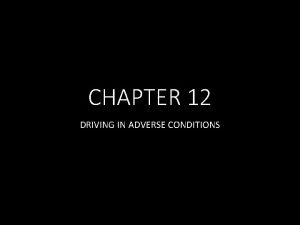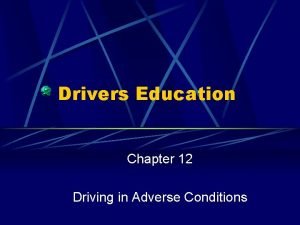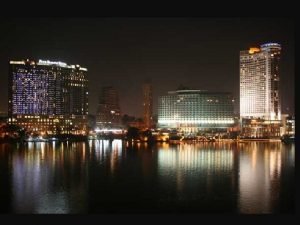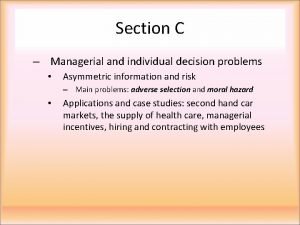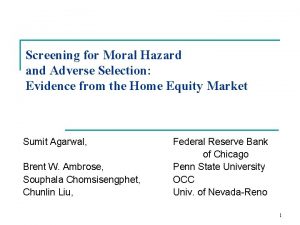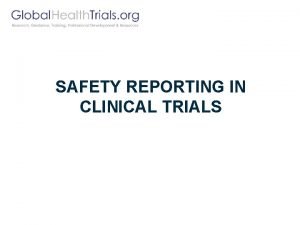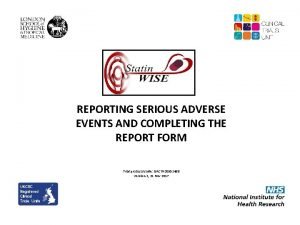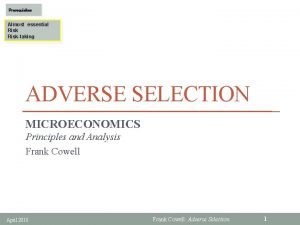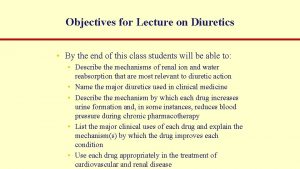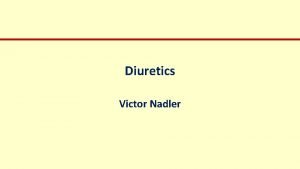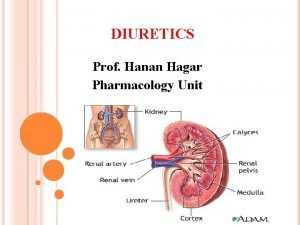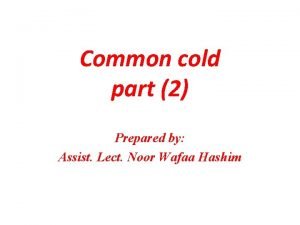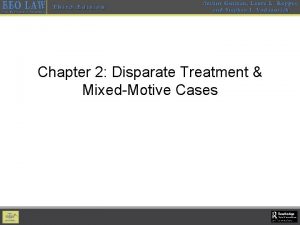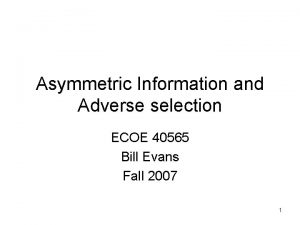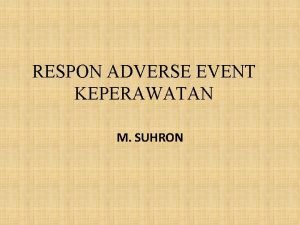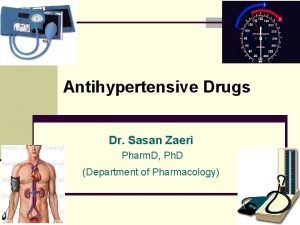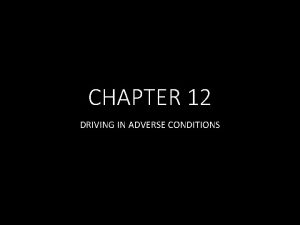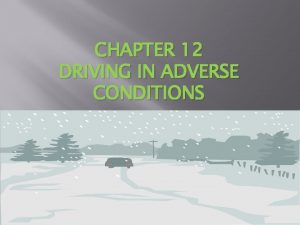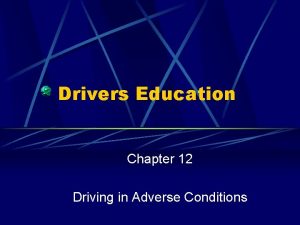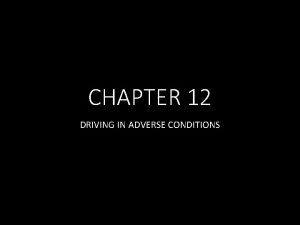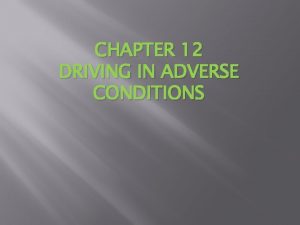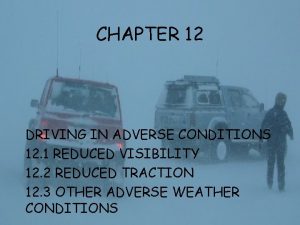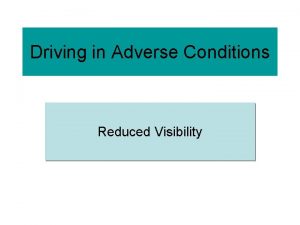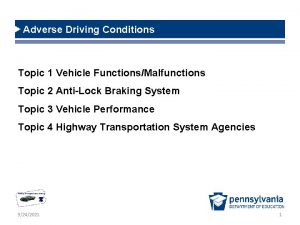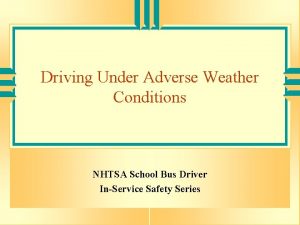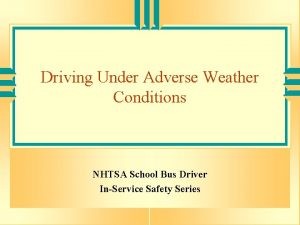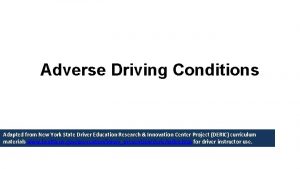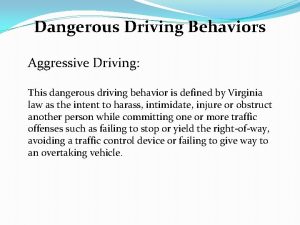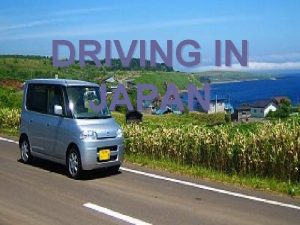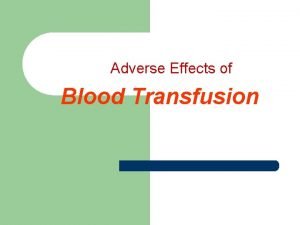CHAPTER 12 DRIVING IN ADVERSE CONDITIONS Ch 12






























- Slides: 30

CHAPTER 12 DRIVING IN ADVERSE CONDITIONS

Ch. 12 Vocabulary • • • Controlled braking. Exhaust pipe. Fishtail. Hydroplaning Overdriving headlights Oversteer situation Rocking Skid. Understeer situation-

Reduced Visibility • Reduced Visibility means driver’s need more time for the IPDE Process and apply the Zone Control driving Techniques.

What else…… • Slow down to give yourself more time. • Scan to identify hazards early. • With reduced vision predict other roadway users may enter your path of travel. • Position your vehicle early with extra space cushion. • Execute driving actions gently to maintain control of your vehicle.

Your Vehicle Windows 1. Keep windows clean – line of sight restriction(this is the most important rule). 2. Moisture build-up – 1. turn on defroster front and rear 2. use AC and/or heater if it will help. The rule for windows is “keep it clean. ”

Sun Glare • At times, sun glare can create severe and blinding glare conditions. • Sun visor and sun glasses can help. • Avoid looking toward the sun. • Other drivers may miss your signal when the sun is behind you. • By driving with low-beam headlights on all of the time, you help other drivers see you.

Dawn and Dusk Dawn and dusk driving can also create dangerous situations. The low visual contrast between moving vehicles and the driving scene can be deceiving.

Driving at Night is the hardest to drive a vehicle. • Low levels of light limit your ability to use the IPDE Process. • Headlights – use high-beam when possible, use low -beam when approached by another vehicle, passed, or when following another vehicle, use lowbeam when driving in fog or heavy smoke conditions.

Driving at Night is the hardest to drive a vehicle continued… Also use low-beam in bad weather; snow, fog, or heavy rain; high-beam will reflect more light back into you eyes, will see less • Meeting other vehicles who fail to use low-beam – briefly flick headlights, no change – slow, move to lane position 3, glance at right edge of road • You don’t stare into the headlights because you could be blinded for up to 3 seconds instead of the one if you look away quickly.

Fog • Use low-beam headlights. WHY? • When you use you high beams it reflects and blinds you the driver. • Fog also reduces ability to judge distances. • Be prepared to park safely off highway.

5 rules for driving in the rain • Wipers on. • Keep windshield clear. • Use low-beam headlights. • Reduce your speed. • Be prepared to pull off highway.

Snow • Drive slow and steer carefully. • Reduces your vision. • Covers your roadway markings. • Ice can build up on your windshield. • Keep windshield, headlights, and taillights clean.

You Are the Driver • Be prepared to slow and steer carefully. • Keep windows, headlights, and taillights free of snow and slush. • Consider delaying travel until roads and weather conditions improve.

Wet Roadways • When rain starts • Mixes with dust and oil, road becomes very slippery • Reduce speed • Hydroplaning – the tires loses road contact by rising up on top of water • Two rules for not hydroplaning: Reduce speed and use properly inflated tires with good tread • Hydroplaning is caused by a combination of standing water, speed, and tire condition.

• • • Steps for driving in Deep water Don’t know how deep, don’t drive through it. Floods cause more deaths than any other weather condition and 60% are vehicle related. Estimate water depth – watch other vehicles, don’t enter if it touches the bottom of your vehicle. Just over rims – drive slowly, drive on higher center of road and avoid the soft edge. Apply light brake pressure with left foot to build friction and heat brake pads. Leaving water – check brakes, if it pulls or not stop, drive slowly applying the brakes to dry them out


Snow • Driving techniques for snow • Gentle acceleration, steering, and braking are the keys to vehicle control. • Use all season tires to improve traction. • Many states allow the use of tire chains at certain times.

• Rocking a vehicle • Drive forward a little, then back a little, keep repeating to work your way out. • 4 rules for rocking a vehicle: 1. Straighten your front wheels. 2. Gently accelerate forward. 3. Let up on the accelerator then shift to reverse and do the same. Then do the same in drive. 4. Continue doing this until your vehicle has cleared the tracks.

Ice • Predict the worst when ice begins to form • Traction is cut in half from 0 degrees to 32 degrees Farenheit. • Squeeze brakes lightly to check your traction in icy areas, at low speeds. • Ice on Bridges are first • Freeze before other roadways • Cold air circulates above and below

• Black ice • Ice that forms in thin sheets on the streets • Ice in Tire Tracks • Driving in tire tracks, the snow will pack down into ice • Avoid by moving right, lane position 3

• Also Gravel and skidding • Gravel on the road will affect your traction. • Your chance of skidding will always increase in low -traction situations.

Skidding • In extreme reduced-traction situations, your tires may lose all or part of their grip and cause a skid. • If your vehicle skids left you should steer to the right. • Over-power skid • Over-braking skid • Front-wheel skid • Rear-wheel skid • Skidding in a curve

Understeer and oversteer • An understeer situation is when you do not turn the steering wheel enough. • An oversteer situation is when you turn the wheel to much. • Which of these do young drivers tend to do?

Fishtail and Controlled Braking • Fishtailing is sliding of the rear of a vehicle from side to side. • Controlled braking is reducing speed as quickly as possible while maintaining steering control of a vehicle.

3 rules for fishtailing • 1. Release the accelerator or brake. • 2. Steer precisely in the direction you want your vehicle to go. • 3. Keep on track with the front of your vehicle even though the rear will continue to fishtail.

Follow these steps for Controlled Braking • With heel on floor put your foot on the brake pedal. Press hard enough to slow your car fast without locking the wheels. • If your wheels lock let up just enough to let the wheels start rolling. • Keep using this process until you come to a stop.

ABS • ABS stands for Anti-Lock Braking system • What it does: it allows you to use the brakes a hard as you want and still turn the steering wheel.

OTHER ADVERSE WEATHER CONDITIONS • Strong Winds-can reduce your vehicle control. • Hot weather • Cold weather • Be alert for exhaust leaks • Do not race a cold engine • Do not set your parking brake

Carbon Monoxide • The temperature light or gauge tells you that the engine is running to hot. • Carbon Monoxide gas is created when your engine runs.

Tips for Smooth Winter Driving • Look and listen for traffic reports. • Keep ALL windows clear and clean. • Respect lower speeds. • Keep a safe following distance. • Try to keep moving in snow. • Use a lower gear on slippery roads. • Avoid cruise controls.
 Chapter 12 driving in adverse conditions hidden message
Chapter 12 driving in adverse conditions hidden message 5.2 driving in adverse conditions assignment
5.2 driving in adverse conditions assignment Skid meaning in driving
Skid meaning in driving Driving in adverse conditions
Driving in adverse conditions Special driving conditions
Special driving conditions Adverse reaction definition
Adverse reaction definition Near miss event example in hospital
Near miss event example in hospital Adverse selection
Adverse selection Adverse selection
Adverse selection Adverse reaction definition
Adverse reaction definition Adverse reaction definition
Adverse reaction definition Adverse events in hospital
Adverse events in hospital Adverse events in hospital
Adverse events in hospital Puerperal sepsis meaning
Puerperal sepsis meaning Adverse selektion
Adverse selektion Acetaminophen mechanism
Acetaminophen mechanism Loop diuretics adverse effects
Loop diuretics adverse effects Analgesic mechanism
Analgesic mechanism Sitaglimet
Sitaglimet Adverse selection
Adverse selection Azalastyna
Azalastyna Furosemide side effects
Furosemide side effects Diuretic drugs classification
Diuretic drugs classification Hayanil tablets
Hayanil tablets Adverse treatment
Adverse treatment Adverse selection
Adverse selection Adverse event adalah
Adverse event adalah Fetal warfarin syndrome mnemonic
Fetal warfarin syndrome mnemonic Adverse effect of alpha blockers
Adverse effect of alpha blockers Moa of alpha adrenergic blockers
Moa of alpha adrenergic blockers Alpha blockers
Alpha blockers
